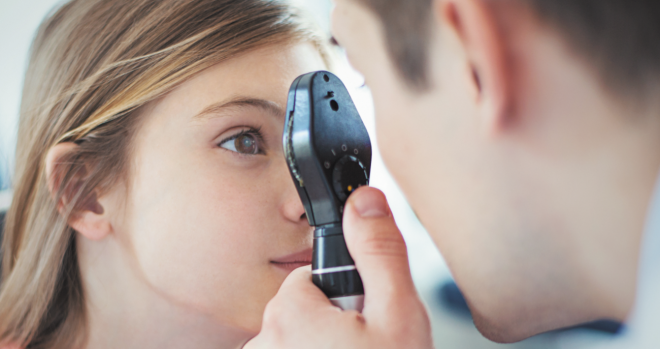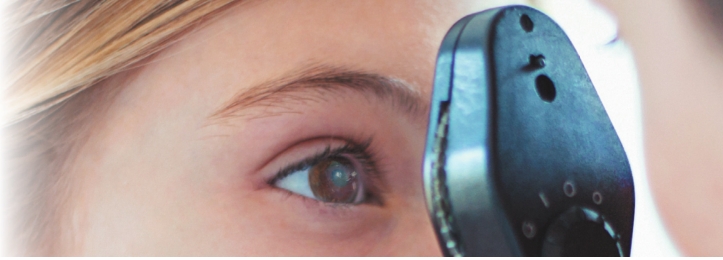CATARACTS IN CHILDREN

When someone hears the diagnosis of cataracts, they usually think of this disease process occurring in adults. The fact is that children can also have cataracts. Cataracts can occur at any age, starting at birth.
If a child is born with cataracts, it is called a congenital cataract. If it occurs after birth, it is called an infantile cataract. If it occurs even later, it is called a juvenile cataract. Whatever the time that it occurs, it must be identified and treated. Otherwise, the child can become blind for the rest of his or her life.
The pediatrician is extremely important in identifying cataracts. One of the main presenting symptoms is having an abnormal red reflex. This is a reflex that the pediatrician looks for in the pupils at birth and at well-child checks. If it is abnormal, it can be a sign of cataracts, corneal abnormalities, retinal tumors such as retinoblastoma, or large refractive errors that require glasses at a young age. Whatever the cause, the child needs an evaluation by an ophthalmologist in the near future.
If it is a significant cataract, it will need rapid treatment. If a child is born with a unilateral cataract, it needs to be removed by 6 weeks of age for best chance of improved vision. If it is bilateral, both should be removed by at least 10 weeks of age.
If the cataract develops after birth, it can also be picked up by abnormal red reflex exam at the child's well-visit check. Symptoms that the parents may notice include abnormal appearance to the pupil. This can range from a white cataract that can be easily seen, or it zmay be less noticeable. An abnormal appearance on photos may bring the child in to his or her doctor. Other symptoms include poor or decreased vision, eye muscle abnormalities such as strabismus (deviation of eyes) or nystagmus (abnormal jumping of the eyes).
If
a cataract is noted, then a cause is usually looked for if they are in
both eyes. If the cataract is in only one eye, usually no work up is
needed. Causes of cataracts include genetics, metabolic disorder,
infectious causes, inflammatory causes, systemic disorders or trauma.
One of the biggest causes for child-hood cataracts is
being inherited from another family member. If a mother, father or
sibling has a history of childhood cataracts, the child should be
followed closely. This is especially true if it is inherited in an
autosomal dominant fashion. This usually means a child will have about a
50 percent chance of developing a cataract. Metabolic disorders include
condi-tions such as diabetes, high calcium levels, galatosemia and a
number of other causes. Infectious causes include rubella,
cytomega-lovirus, syphilis, herpes simplex, toxoplas-mosis and many
other causes. Inflammatory disorders such as sarcoidosis and juvenile
ar-thritis can also cause cataracts. Chromosome abnormalities such as
Down syndrome have a much higher rate of cataracts at a young age.
Trauma to the eye is a large cause of cataracts in children that can
happen immediately or days or weeks after the trauma. Lastly, we of-ten
find no cause for the cataracts at all.Once the cataract is identified,
treatment must be decided. First, it needs to be determined if the
cataract is large enough to block the vision and require surgery.
Generally, the cataract needs to be greater than 3 mm to require
surgical removal. Even if the cataract is smaller, it may cause the need
for glasses or cause amblyopia that may require non-surgical treatment.
One such cataract is an anterior polar cataract that may be only
pinpoint in size, but can cause amblyopia in up to 25 percent of
children that are identified with this type of cataract. If the cataract
if small and not causing any vision problems, it may require
observation only and never cause a problem. These still need to be
followed because they can enlarge.
Some
enlarge very slowly over years and years. Others can worsen even
overnight. It is important for the parents to understand this and to
bring to child back immediately if there are any signs of significant
worsening of the cataract.If surgery is required, it is generally done
outpatient, and the child will go home that day. If it is an extremely
small baby, they may have to remain overnight for observation. For
children, their surgery is done with general anesthesia. They are unable
to remain awake and cooperate like adults do for cataract surgery. The
surgery is also different for children. If the child is a baby,
especially under 6 months of age, a replacement lens will not be placed
as in adults. They will be left aphakic (no lens) and be fitted for a
contact that will remain in and be changed intermittently. If they are
older, especially over a year of age, a lens may be placed to replace
the lens that was removed, just like adults. The difference is that
children are generally left hyperopic (far-sighted) after surgery due to
the eye still growing with time. The younger child is left more
hyperopic that the older child and often will require glasses after
surgery. Another difference with surgery is that anyone, including
adults, that have cataract surgery can develop a membrane behind the
implanted lens. This can easily be opened with a yag laser in a
cooperative patient. If the child is too young or has developmental
problems that will not allow for a laser procedure awake, then his
posterior capsule (that usually is left intact in adults) will be opened
at the time of the original surgery along with removal of some of the
vitreous behind the lens. Even with doing this, some children will still
develop a secondary membrane that may require removal under general
anesthesia. The other significant difference with children is they often
have amblyopia due to the cataract, especially if it is present in only
one eye. Amblyopia means that the child is unable to see perfectly from
that eye even when the cataract is removed because his or her brain
does not know how to properly use that eye. For treatment, the child
will need to patch the better-seeing eye for part of the day. A perfect
surgery can be done, and the child can still be blind if he does not
receive proper amblyopia treatment. This is also a reason children need
their cataract removed when discovered. If they are under about 8 years
of age and develop a cataract, they are at risk of developing amblyopia.
The younger and longer they have had the cataract, the higher the risk
of loss of vision due to amblyopia. That is why it is so important to
identify children with cataracts and treat as soon as possible.With
early identification and treatment, a child can end up with excellent
vision and not be limited in his future potential in life. If not
treated early, they may be legally blind for the rest of their lives.As
with any surgery, risks are involved, such as infections and retinal
detachments. Fortunately, these are not extremely high risks.
The
biggest thing that needs to be followed in these children is for the
development of glaucoma with increased pressure in the eye. Any child
that has required cataract surgery has a lifetime risk of developing
glaucoma. The younger the child is that requires surgery puts him or her
at a higher risk of developing glaucoma. If this is not identified and
treated, the child can then become blind from this condition.Cataracts
can occur at any age. Parents can help identify cataracts, and
pediatricians and primary care doctors provide an essential service in
identifying these children to be sent to the ophthalmologist. It is a
scary diagnosis for a parent to hear, but with surgery and proper follow
up and treatment, the child can end up with good vision. It is often
not a quick fix and requires a joint effort of the family and the
child's ophthalmologist to obtain the best results.
